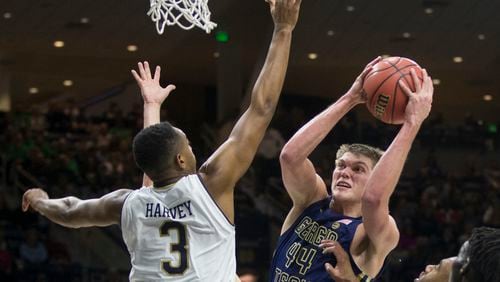In the preseason, Georgia Tech center Ben Lammers was hopeful that the offseason development of big men Sylvester Ogbonda and Abdoulaye Gueye might mean a little break for him once the season began.
Against Notre Dame on Wednesday, Lammers played 40 minutes, the third time this season that coach Josh Pastner has kept him on the floor for the entire game. The same may happen Saturday, when Tech plays Pittsburgh (2 p.m., Raycom/ACC Network).
“You know, I’ll do it for as long as he needs me to,” Lammers said. “At this point I’m used to it.”
Lammers’ tone and body language didn’t quite speak resignation, but they weren’t communicating bright-eyed enthusiasm, either. There’s a reason that, among the 159 players averaging the most minutes played in the country going into Friday’s games, Lammers was the only center and the only player 6-foot-10 or taller. It’s not easy for a player that big (Lammers weighs 234 pounds) to play so many minutes, and it’s perhaps not a recommended course of action.
After Thursday’s games, Lammers was ranked 30th at 36.0 minutes per game. Lately he’s been joined by guards Jose Alvarado, who has received three minutes of rest in the past four games, and Josh Okogie, who has played 37 or more minutes in five of Tech’s past six games.
Further, Pastner said, he has been pushing the team hard in practice to sharpen a young group for ACC play.
“But I am conscientious of that because I know it’s a grind,” he said. “I know the minutes they’re playing, so I’ve got to be smart.”
Pastner, who calls himself a “feel” coach, has felt compelled to keep them on the floor because of – and you may have heard him use this phrase – Tech’s limited margin for error. With Pastner feeling the need to squeeze as much out of every possession as possible, he has been reluctant to take them off the floor.
When Lammers sprained his ankle in the second game of the season, Pastner had mixed feelings about playing him when he was so hurt that he didn’t even practice. But, because so much of Tech’s schemes at both ends of the floor center around Lammers, last season’s ACC defensive player of the year, Pastner kept playing him.
“It’s no surprise,” said Lammers, who played five 40-minute games last season. “At least body-wise, it’s not like it’s going to do any more damage to my ankle. I can handle it as long as he needs me.”
Part of the predicament, also, is the drop-off. Earlier this season, Pastner moved Gueye strictly to the backup center role, but his development of late led Pastner to move him back to the starting power-forward job. Lammers’ backup is Sylvester Ogbonda, whom Pastner evidently does not trust enough at this point. Alvarado’s backup is Justin Moore, but he has not been dressing because of what Pastner called a “personal situation.”
Okogie could be subbed for Brandon Alston, Tadric Jackson or Curtis Haywood (recently returned from a shin injury), but his value may be too great.
Pastner is not the only coach squeezing players for minutes. Syracuse has had 26 players with 40-minute games this season, according to sports-reference.com. Boston College has had 14. Notre Dame, like Tech, has had seven. Five ACC teams have had none.
Tech coaching great Bobby Cremins was not shy about the practice. In his final 15 seasons at Tech (the team media guide goes back only that far in tracking 40-minute player games), there were 196 instances in which one of his players played every minute. In the 1990 Final Four season alone, there were 35 by “Lethal Weapon 3” – Kenny Anderson, Brian Oliver and Dennis Scott.
Pastner acknowledged that he has moments where he thinks he should get Lammers, Alvarado or Okogie out but decides against it. He does try to combine regular timeouts with TV timeouts to build in longer breaks. By the rules, a timeout called in the 30-second window before a scheduled TV timeout (which takes place at the first dead ball after the 16-, 12-, 8- and 4-minute marks of each half) will count as the TV timeout. So he’ll try to call one at, perhaps, 8:35, to get a full timeout followed by the eight-minute TV timeout shortly after.
The minutes did seem to wear down Lammers last season. His two lowest-scoring games of the season and one of his low-rebound games were in the final five games before the NIT began. To help recover, Lammers said he has done a lot of stretching in addition to a more advanced, if somewhat frightening, health improvement method.
“They have this laser,” he said. “It feels a little hot, but I don’t know exactly what it does. You have to put on these special glasses and you go in this little room, they scan this little laser on the part that’s sore.”
Either Lammers is getting welded or the Jackets are counting on medical technology to help keep him fresh. Whatever it is, Tech is hoping it works, because the simpler method – resting him during games – doesn’t seem likely.
About the Author







